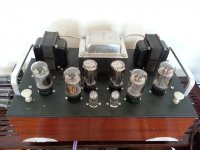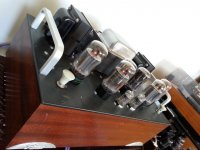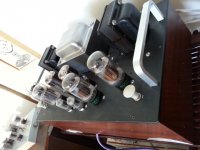Wave, you mean these? I've got some too.The photo doesn't do justice to their 'pinkness'.
Exactly, Todd!
Is there any reason why you need two 5U4's? With one rectifier, you would need to replace fewer caps.
jeff
It's the way the amp was designed. I don't have any idea about tube amp design, but my father thought it was overkill to have two 5U4's also, drawing about a full amp combined, at least for home audio use. And I'm not concerned about having to replace six caps that will only cost around 15 bucks or so.
Keep in mind though that this amp was designed and used in a Baldwin electronic organ and was used for both the manuals and pedal stops, so the amp had to be rather robust to fill a small to medium sized church. Even with efficient speakers, 23-28 watts doesn't go all that far when you're trying to fill a large area like that with a full range of frequencies, especially those pedal notes.
Your loud 'ticking and popping' sounds could be a bad solder connection or broken lead.
If you can do it safely, considering the lethal voltage everywhere, I would suggest turning the amp upside down (make sure it's stable), power it up with a crappy test speaker connected, turn the volume up a little, then tap the leads of all the components and all solder connections with something long and non-conductive, like a chopstick. This will expose any bad solder joints or broken leads.
[edit] another thought: clean the tube pins and socket holes somehow too, it might be a bad contact there. Spraying some Caig DeOxIt (sp?) will help. I'm not sure how to clean the socket holes other than spraying them. Maybe insert a small drill bit and scratch it around a bit.
..Todd
If you can do it safely, considering the lethal voltage everywhere, I would suggest turning the amp upside down (make sure it's stable), power it up with a crappy test speaker connected, turn the volume up a little, then tap the leads of all the components and all solder connections with something long and non-conductive, like a chopstick. This will expose any bad solder joints or broken leads.
[edit] another thought: clean the tube pins and socket holes somehow too, it might be a bad contact there. Spraying some Caig DeOxIt (sp?) will help. I'm not sure how to clean the socket holes other than spraying them. Maybe insert a small drill bit and scratch it around a bit.
..Todd
Last edited:
Wow, it's been a crazy busy time these past few days, hence my absence here.
At any rate, I ordered the new electrolytics Tuesday and got them in yesterday, bought a new heavy duty "long" toggle switch to replace the little cheap power switch that was installed by the other guy, and thoroughly inspected the every connection head to toe on the amp when i had the chance.
Today I will be installing the new caps and switch and then powering it up!
At any rate, I ordered the new electrolytics Tuesday and got them in yesterday, bought a new heavy duty "long" toggle switch to replace the little cheap power switch that was installed by the other guy, and thoroughly inspected the every connection head to toe on the amp when i had the chance.
Today I will be installing the new caps and switch and then powering it up!
Got everything installed and now playing. There's zero hum or hiss. It's dead silent in that regard, however...
It sounds fine when there's music playing, but whether the gains are all the way up or down, there's a faint "sizzle" sound coming from the speakers, mostly from the tweeters. The sizzle is independent of each channel also. It almost sounds like the surface noise of a record.
Could this just be the new caps (burning in) or something? Could it possibly be the old original coupling caps going? Anybody ever witnessed this type of noise before?
I'll post up some pictures later tonight when I get some spare time.
And many thanks in advance for any info you guys can provide me!
It sounds fine when there's music playing, but whether the gains are all the way up or down, there's a faint "sizzle" sound coming from the speakers, mostly from the tweeters. The sizzle is independent of each channel also. It almost sounds like the surface noise of a record.
Could this just be the new caps (burning in) or something? Could it possibly be the old original coupling caps going? Anybody ever witnessed this type of noise before?
I'll post up some pictures later tonight when I get some spare time.
And many thanks in advance for any info you guys can provide me!
Could this just be the new caps (burning in) or something?
I've never heard new caps make any noise.
Any old carbon resistors in the PS?
jeff
Well I shut the amp back down, switched the 5751 tubes from left to right just to see if that had any effect on the problem and it now seems that the noise is completely gone! That was over an hour ago and it's still running nice and silent. I guess it was just a dirty contact or something.
Anyway, here's some pics from today...
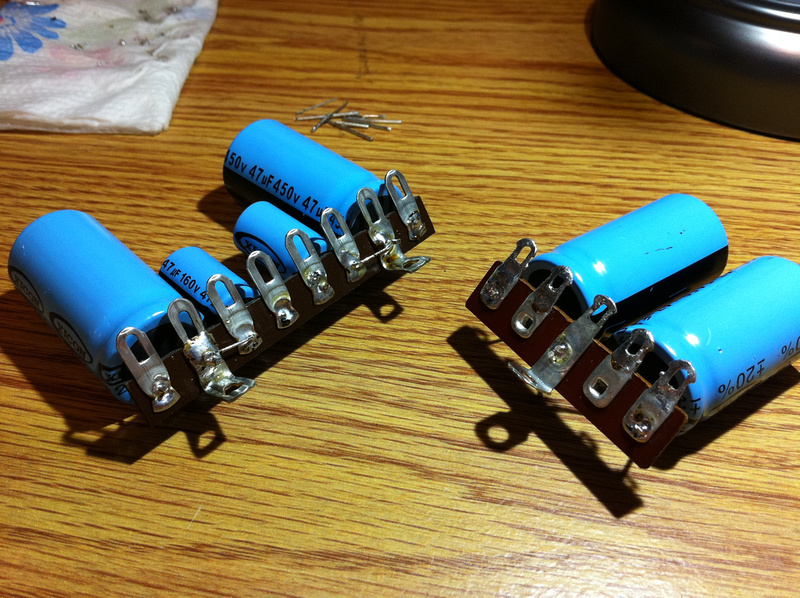
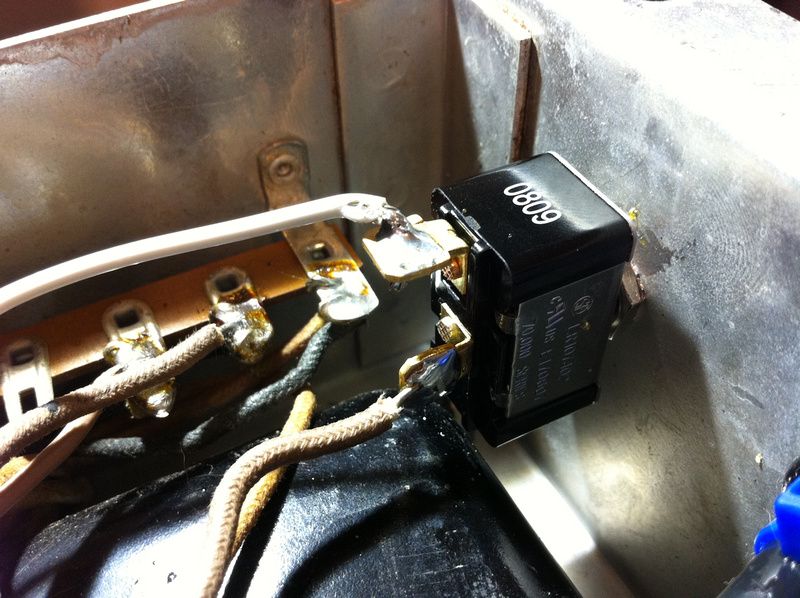

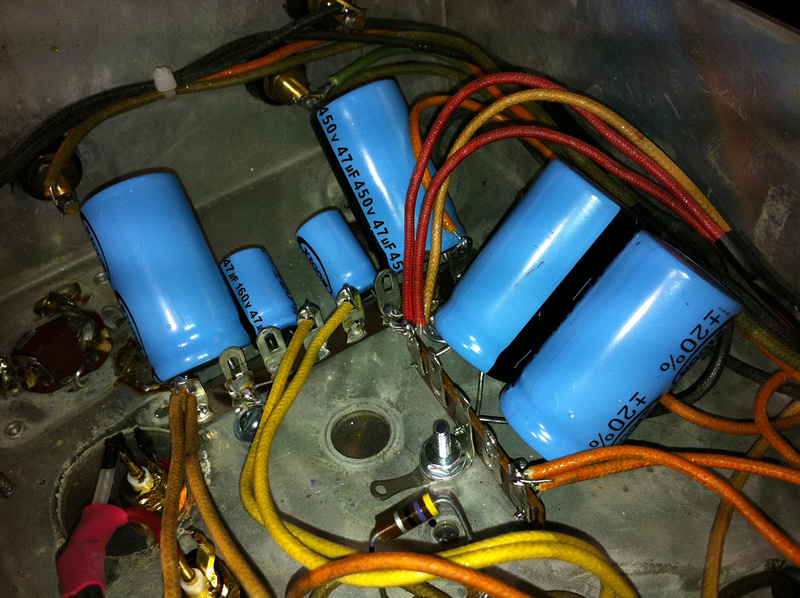
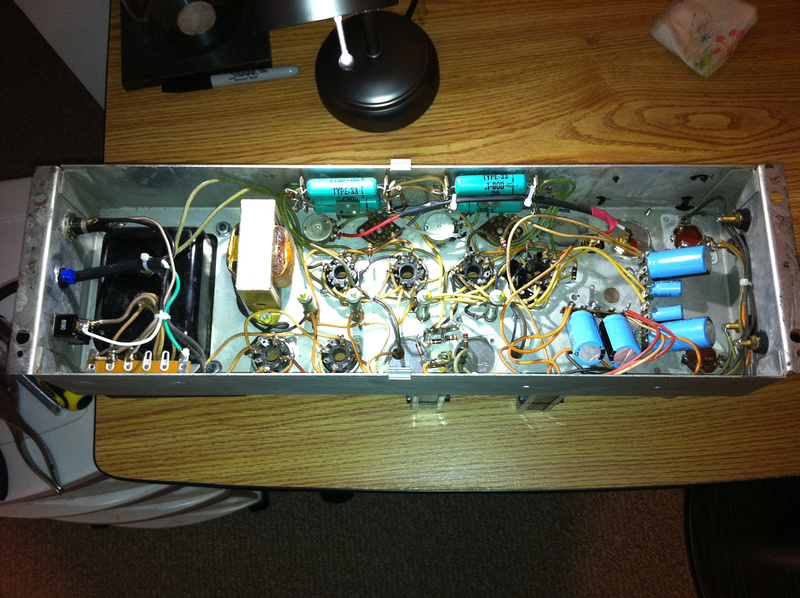

Anyway, here's some pics from today...






It seems like the sizzling was a 5751 tube socket pin connection. That makes perfect sense.
..Todd
Well no, I don't think it does actually. I'm beginning to think it's either one of the 5751 tubes or one of the 6L6's that might be a little flaky. Within the first hour and a half or so of operation from being completely cold, this sizzling sound occurs. It sometimes sounds like air leaking from a tire but not constant. It varies in intensity and duration.
If I lightly tap the 5751 of the channel in which is making this sound, you can hear the tap effect the sizzle. Same holds true if you tap either of the 6L6's in that same channel.
The thing is, my brother rolled the tubes in this amp shortly after getting it. He thinks he knows what he's looking for when buying old NOS tubes off of eBay, but he doesn't. He figures if the tubes are a well known name and the seller says they measure good, then they have to be good. This obviously isn't the case as the seller often doesn't test the tubes properly or doesn't test them at all.
Furthermore, he had two other similar issues with his 300B amp after he started rolling the tubes in it, the last of which ultimately killed the amp. IIRC, half way through a CD he was playing, one of the 300B tubes started glowing bright cherry red. There's no telling how long the tube was running like that until he noticed it. Of course, when he did notice it, he shut the amp down immediately. Ever since then, no matter what tubes he tried in it, that channel was dead and I think the 300B in that channel wouldn't even heat up anymore.
So in short, what I'm trying to get at is that I have really no clue as to how good these tubes in this amp really are. They all measure great and are very closely matched to each other, even the two 5U4's. I also don't know what the 6L6's are brand-wise. There's no markings on them anywhere. All I know is that the 5U4GB's are GE and the 5751's are RCA.
I think I'm going to completely re-tube the amp as even the 5U4's make a little "jingling" sound of their own when you put your ear down close to them. Actually, you can hear them jingling when sitting on the floor in front of the amp.
Have any of you guys ever witnessed tubes that measured good but had issues while listening to them? What was the cause?
Again, many thanks in advance!
I would pull them and clean the sockets and pins before rushing out and buying more tubes.
jeff
I plan on doing that actually. What would be the best way of cleaning them? Probably use some Deoxit, but what about actually, physically cleaning the sockets?
Also...
I'm sitting here listening to some Yellowjackets and man is this amp tight and punchy! It has that nice hard "thwack" that goes right through your body, and I'm not even playing it that loud. I can't being in an apartment and all. But still, it's got a nice hard hit to it. I did crank it for a few seconds and it only got better and never ran out of steam, even with these 86dB NHT's. The bass is very healthy and articulate and have plenty of texture and detail. Loads of drive and attack!
Sound stage width and depth is equally amazing. It easily stretches out pass the speakers in all directions, not to mention that the speakers practically disappear in the process. Vocals and soloists float in space either in front of slightly behind the speakers and wall. There's a great sense of "being there" with a very tactile feel. Midrange presence and detail is excellent. Little nuances near and far can easily be heard and located across the stage. There's even a great deal of stage hight which of course gives a good sense of a life size performer right in the room.
The top end is just as magical as the rest of it. Open, detailed, airy, controlled, extended and clean with that typical tube warmth to it, but never veiled or held back by any means of the term.
This amp truly displays and goes well beyond the original cost of the NHT 2.9's asking price of $2500. I have heard loudspeakers at 4x the price of the NHT's that didn't even come close to sounding this good, and all it took was an old 50+ year old tube amp to get the job done right. Then again, that's saying an awful lot about how good this amp sounds too. I noticed this two years ago when I had this amp in my old system. It easily blew away everything I had previous to using the Baldwin, including the Aragon, Cary and the then Adcom I was using at the time. The Consonance M100SE amp I had never even came anywhere close to sounding like this amp.
Hey Chops,
Yeah, you can never really rule out flakey tubes. They are always a crap-shoot; Chinese, Russian, used, new, NOS, even some Mullards, whatever -- there are plenty of trouble-makers out there vying for duty in our amps. It's just the nature of their construction and/or age.
Swapping them out one at a time starting with the cheapest ones might save you a few bucks. Buy them from a dealer that offers returns if they turn out to be flakey (i.e., not eBay). If you replace the output tubes, it would be worthwhile to get the push-pull pairs matched.
But clean the contacts first. Use Deox-it and some small slightly abrasive object (like a gently turned small drill bit?) to scratch (gently) into some fresh metal. Unplug the amp before you do it.
..Todd
Yeah, you can never really rule out flakey tubes. They are always a crap-shoot; Chinese, Russian, used, new, NOS, even some Mullards, whatever -- there are plenty of trouble-makers out there vying for duty in our amps. It's just the nature of their construction and/or age.
Swapping them out one at a time starting with the cheapest ones might save you a few bucks. Buy them from a dealer that offers returns if they turn out to be flakey (i.e., not eBay). If you replace the output tubes, it would be worthwhile to get the push-pull pairs matched.
But clean the contacts first. Use Deox-it and some small slightly abrasive object (like a gently turned small drill bit?) to scratch (gently) into some fresh metal. Unplug the amp before you do it.
..Todd
Hey Chops,
Yeah, you can never really rule out flakey tubes. They are always a crap-shoot; Chinese, Russian, used, new, NOS, even some Mullards, whatever -- there are plenty of trouble-makers out there vying for duty in our amps. It's just the nature of their construction and/or age.
Swapping them out one at a time starting with the cheapest ones might save you a few bucks. Buy them from a dealer that offers returns if they turn out to be flakey (i.e., not eBay). If you replace the output tubes, it would be worthwhile to get the push-pull pairs matched.
But clean the contacts first. Use Deox-it and some small slightly abrasive object (like a gently turned small drill bit?) to scratch (gently) into some fresh metal. Unplug the amp before you do it.
..Todd
Hi Todd,
Yeah, the same holds true with computer equipment as well.
I'll only start replacing tubes if cleaning all the contacts doesn't help first. If cleaning them completely solves the problem, then I have need to replace the tubes, especially the way this amp is sounding right now. It's simply amazing. And of course, getting matched pairs is a must.
I've got plenty of drill bits to go around, so I'll do that as soon as I get my hands on some Deoxit. I think it's kind of funny that you mention unplugging the amp first, but I suppose some people totally skip that and going spraying and cleaning with it plugged in. At any rate Todd, thanks for the tip on cleaning the sockets!
I plan on doing that actually. What would be the best way of cleaning them? Probably use some Deoxit, but what about actually, physically cleaning the sockets?
I actually had better luck with methyl hydrate (or isopropanol) and some small dental brushes that I picked up at the pharmacy.
I tried Deoxit in the output sockets once, but it tends to bake and smell like burning wire. Probably ok to use on the pins, as you could get most of it off.
jeff
Finally have a day off to mess around with my amp some more. First thing this morning, I pulled all the tubes and used a 3/32" drill bit to get to fresh material on the big tube sockets. Unfortunately I don't have a bit small enough in my current bit set to get into the 5751 sockets. I have a larger set of drill bits at my parents house, so the next time I'm over there I'll pick up that set and bring them home with me. I think that set has bits small enough to get the job done.
As for the tubes, I used a small utility knife and lightly scraped the pins to get to fresh material on them as well. A bit laborious but it works.
I swapped out the 5751 tubes for a pair of no-name 12AX7's that originally came with the amp. They don't seem to have anymore gain than the 5751's did which I'm somewhat surprised to find out. I don't know how old they are or how long they have been used but they sound fine.
I also swapped out the "jingly" 5U4GB's with a mixed pair from my father's collection. Both are old tubes out of old radios. One is labeled as a "Realistic Lifetime" and the other a Sylvania. The new 5U4's do NOT jingle like the other ones did. Since I have to return these tubes back to my father, I'll be buying some new 5U4's at some point.
After doing all of this, I put the new 5U4's and 12AX7's in along with the same 6L6's. I fired the amp back up (after a week and a half of sitting unused) and after about a minute, that same faint sizzling, crackling sound started back up, in the right channel this time. It's strange because it also makes like a squeaky stretching sound while warming up to full operating temp. This stretching sound lasts for several seconds, probably about 5-6 seconds. It reminds me of the sound of a small piece of meat in a microwave oven! LOL
I think I have finally narrowed the issue down to a single output tube. I even turned the amp back off, swapped this single tube with one on the other channel, and the noise transfered to the other channel.
It is in fact one of the 6L6's. I noticed from the very beginning that one of the 6L6's has a very faint bluish haze on the glass when running, yet the other tubes do not. Now I know this is a normal occurrence with a lot of power tubes, but it's odd that just one of the 6L6's has this bluish haze, and it's also the causing the noise. The reason I know it's this tube is because I lightly tapped each tube with my bare finger and when this one was tapped, it effected that sizzle/crackle noise. What's also odd is that all these tubes tested perfectly fine with no shorts and are very closely matched.
So anyway, that's where I'm at at the moment. Since I have a new iPhone 4, I still have my old iPhone 3G laying around, so it's been demoted to an iPod Touch! I have it hooked up to the system via the headphone jack playing jazz through Pandora over the WiFi. I forgot how good this phone sounds as I used to use it on my old 2-ch system a couple years ago as well. It has many many hours of break-in time in that respect, probably upwards of a 1000 hours! I'd like to get an outboard DAC for it eventually.
As for the tubes, I used a small utility knife and lightly scraped the pins to get to fresh material on them as well. A bit laborious but it works.
I swapped out the 5751 tubes for a pair of no-name 12AX7's that originally came with the amp. They don't seem to have anymore gain than the 5751's did which I'm somewhat surprised to find out. I don't know how old they are or how long they have been used but they sound fine.
I also swapped out the "jingly" 5U4GB's with a mixed pair from my father's collection. Both are old tubes out of old radios. One is labeled as a "Realistic Lifetime" and the other a Sylvania. The new 5U4's do NOT jingle like the other ones did. Since I have to return these tubes back to my father, I'll be buying some new 5U4's at some point.
After doing all of this, I put the new 5U4's and 12AX7's in along with the same 6L6's. I fired the amp back up (after a week and a half of sitting unused) and after about a minute, that same faint sizzling, crackling sound started back up, in the right channel this time. It's strange because it also makes like a squeaky stretching sound while warming up to full operating temp. This stretching sound lasts for several seconds, probably about 5-6 seconds. It reminds me of the sound of a small piece of meat in a microwave oven! LOL
I think I have finally narrowed the issue down to a single output tube. I even turned the amp back off, swapped this single tube with one on the other channel, and the noise transfered to the other channel.
It is in fact one of the 6L6's. I noticed from the very beginning that one of the 6L6's has a very faint bluish haze on the glass when running, yet the other tubes do not. Now I know this is a normal occurrence with a lot of power tubes, but it's odd that just one of the 6L6's has this bluish haze, and it's also the causing the noise. The reason I know it's this tube is because I lightly tapped each tube with my bare finger and when this one was tapped, it effected that sizzle/crackle noise. What's also odd is that all these tubes tested perfectly fine with no shorts and are very closely matched.
So anyway, that's where I'm at at the moment. Since I have a new iPhone 4, I still have my old iPhone 3G laying around, so it's been demoted to an iPod Touch! I have it hooked up to the system via the headphone jack playing jazz through Pandora over the WiFi. I forgot how good this phone sounds as I used to use it on my old 2-ch system a couple years ago as well. It has many many hours of break-in time in that respect, probably upwards of a 1000 hours! I'd like to get an outboard DAC for it eventually.
Thanks...Does anyone have a slightly higher res version of this schematic? I've got five of these organ chassis, I'm wanting to convert them into sweet hifi tube stereo amplifiers.This is a typical Baldwin design:
An externally hosted image should be here but it was not working when we last tested it.
The scan is poor but you get the overall idea.
baldwin home brew stereo 6L6 stereo power amplifier all original parts
I BUILD A BALDWIN STEREO POWER AMP USING ORINAL PARTS AND CIRCUIT. BETTER THEN MOST AMPLIFIERS IN THE MARKET TODAY OR MEGA BRAND VINTAGE AMPLIFIERS.
SOUND REAL GOOD AND SMOOTH.
I BUILD A BALDWIN STEREO POWER AMP USING ORINAL PARTS AND CIRCUIT. BETTER THEN MOST AMPLIFIERS IN THE MARKET TODAY OR MEGA BRAND VINTAGE AMPLIFIERS.
SOUND REAL GOOD AND SMOOTH.
Attachments
- Status
- This old topic is closed. If you want to reopen this topic, contact a moderator using the "Report Post" button.
- Home
- Amplifiers
- Tubes / Valves
- Project: Baldwin Tube Amp...
